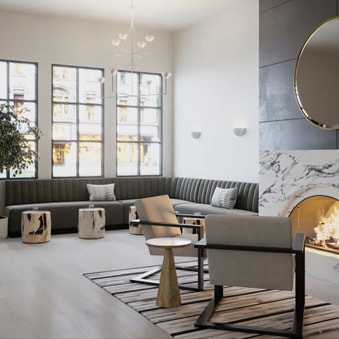How to Mix Patterns
Integrating pattern is one of the most fun ways to liven up your space. But how do you choose which patterns to use? Read this quick guide to find out.

Creating a pattern plan for your home is not only easy, but it’s also fun! You may be intimidated by the process, but once you get started, you won’t want to stop. Read on to learn how designers mix pattern to create stylish and balanced rooms.
The first thing you should do when determining the patterns to use in any room is start with a print that you love. Then you should work in color-related fabrics in two other scales. This will guide you to a room that has scale and balance.

Pattern Types
If you’re using patterns in your space, you should always use solids, too. Solid fabrics might be the upholstered piece in the room or perhaps bed covering. For greater depth, use solid fabrics with tactile interest such as a basketweave mohair, matelassé, or a hair on hide.
Patterns with small motifs repeated over large areas are very versatile when used in a mixed pattern scheme. Similarly, quilted and embroidered fabrics, as well as embossed leathers, can provide a bit of pattern through texture.
One of the most classic patterns is the stripes. Stripes are perhaps the most versatile of all patterns, and they come in a wide range of widths and colors, from narrow ticking to broad awning stripes, making them friendly companions to many other fabric patterns. Geometric prints are another type of pattern that mixes easily. These include a large range of patterns from simple checks and plaids to complicated angular patterns like Greek key prints.
And then at last, there are organic patterns, which take inspiration from the natural world. These mix well with many other patterns and will add richness and romance to any setting.

Colors and Patterns
Color should be a key consideration when choosing patterns. Be mindful that all the patterns in a room should share a common color scheme to create a pleasing combination. Your colors don’t have to match exactly, but they should be similar; The differences between them will add interest to the combinations. If you prefer more bold look, feel free to venture outside a single color range, but just ensure the color complements the existing design.

The 60/30/10 Rule
When determining how and where to use patterns, one method for balancing the patterns in a room is to follow the 60/30/10 Rule. Use your favorite pattern in 60% of the room, your second favorite in 30% of the room, and your third favorite in only 10% of the room. This balance makes for a happy camper.

Working with Scale
Be sure to also vary the scale of your pattern. Too many small prints can be dull or busy, while two or more large prints will fight for attention. A family of large, medium and small patterns can coexist without that kind of rivalry. Large-scale patterns are perfect for large-scale furnishings including duvets and rug. Medium prints on medium sized furnishings such as a chair or duvet. Smaller scale prints work well as accent pillows or coverings for occasional pieces like a bench cushion.

Work with an Interior Designer
Williams Sonoma Home offers free design services to our customers. Work with our stylists and decorators, in your home or at your local store, to create your dream home. Schedule an appointment with the Williams Sonoma Design Crew or work with your local store to get started.








